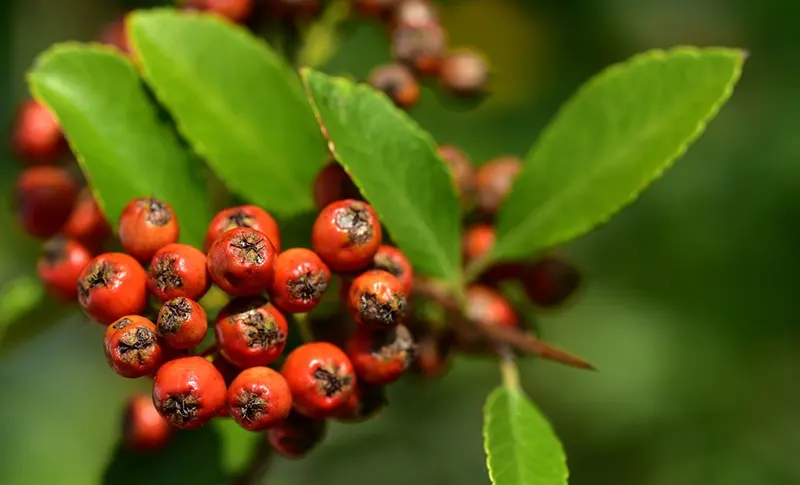Pyracantha Bonsai | Ultimate Care Guide
You may know the Pyracantha bonsai by another name, namely, Firethorn. It stems from the Greek words pyr for fire and akanthos for thorn. These evergreen trees belong to the rose family, and they present a stunning display with colorful berries.
In this ultimate guide for the Pyracantha bonsai tree, we’re going to cover everything you’ll ever want to know about the genus. You won’t regret having it in your collection, especially when the berries appear in the foliage. We’ll also show you what you need to do to provide proper care.
Here's what you'll find in our Coral bark
Japanese maple bonsai species guide:
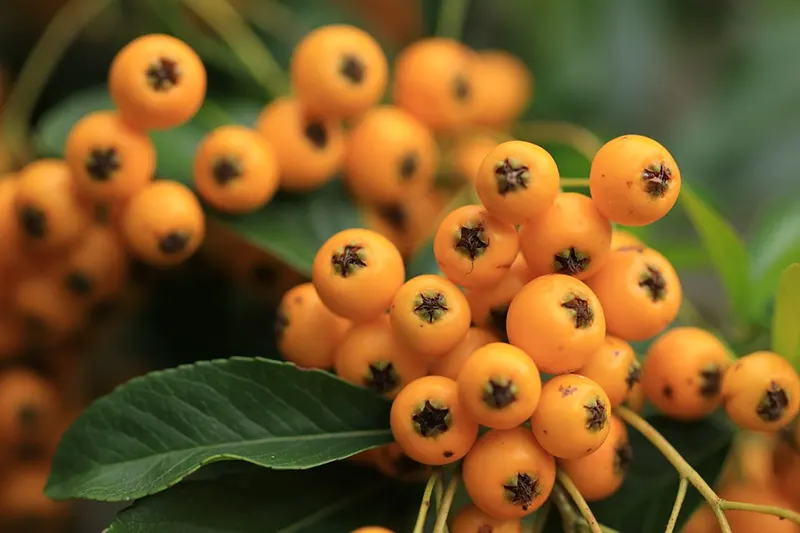
Quick Info Sheet for Pyracantha
🌞 – Semi-shade or full sun, preferably outdoors; frost protection in winter
💦 – Frequent water in warm seasons, and less in winter
🍏 – Balanced fertilizer during the growing seasons
✂️ – Pruning in mid-spring or late summer
🎍- Repot every two to five years, depending on age
🐛 – Aphids, scale insects, caterpillars, fireblight, leaf miners
🥜 – Seeds, cuttings, air layering propagation
🏠 – Uses include being ornamental, flowers for bees, food source, hedge barrier
Pyracantha Scientific Classification
- Clade: Angiosperms
- Clade: Eudicots
- Clade: Rosids (Rose)
- Order: Rosales (Rose)
- Family: Rosaceae (Rose)
- Sub-Family: Amygdaloideae (Rose Plum)
- Tribe: Maleae (Apple)
- Sub-Tribe: Malinae (Apple)
- Genus: Pyracantha (Firethorn)
Information on the Pyracantha Bonsai
The Firethorn tree is stunning and grows natively from South Asia to Southern Europe. It’s related to the Cottoneaster plant, but it has thorns and serrated edges in comparison. While there are only seven species, there are a few variants that make bonsais look amazing.
The main difference between the pyracantha species is with the berries. They have various colors, which means you can put on quite a show when the flowers and fruit appear. What makes this tree so exciting is that fossils of the Firethorn were discovered in Denmark in what is called the middle Miocene strata. While it may not be the time of the dinosaurs, it stretches back to about 16 ma to 11 ma (million years ago)
Pyracantha meaning and symbolism
When it comes to the Firethorn bonsai, there are both positive and negative symbols associated with it, depending on how you look at it. On the positive side, you have its fiery nature that represents passion, love, drive and motivation, sexual chemistry, and burning desire.
The Pyracantha bonsai also has a dark side. While it’s seen as a form of protection, there are also aspects of aggression, anger, dislike, and anything associated with being upset. It’s up to you and how you nurture it, so make sure you share your spirit of love and passion when you spend time with the tree.
What the Firethorn Tree Looks Like
If you want to know how to identify the Pyracantha bonsai, you’ll need to look at its stunning features. In other words, you’ll need to pay attention to the leaves, flowers, bark, fruit, and seeds. Here are a few clues so you can determine if you have a Firethorn in your possession.
It’s not to be confused with a Flame Tree, which is a different tree altogether.
Leaves
The Firethorn’s leaves are green and glossy and vary in richness depending on the season. During summer and bright light, the foliage may take on a lighter color. Winter brings with it darker tones as there’s less heat and sunlight intensity.
The edges of the leaves are either smooth or slightly serrated, depending on the species and varieties. When it comes to the shape, they’re usually ovate to lanceolate. Your bonsai will display small to medium-sized leaves, but it’s up to you how much you want to prune to minimize the length. The species also determines if they’re arranged in clusters or alternately.
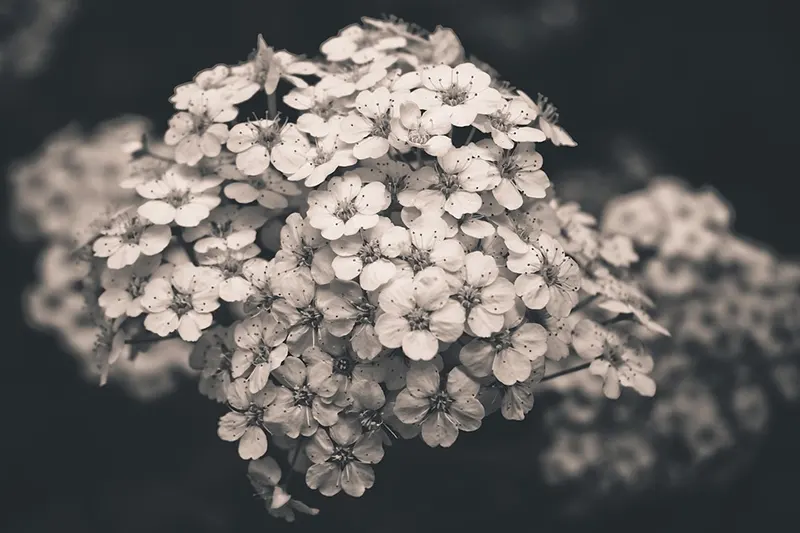
Flowers
All the species have white flowers consisting of five parts and several stamens. Since the Pyracantha tree is hermaphroditic, it is able to self-pollinate. That doesn’t mean it isn’t visited by bees and butterflies that are attracted to the small cluster of flowers when it’s time to bloom.
You’ll usually see the first blossoms appear on branches that are at least two years old. Appearing in early summer, they look like small umbrellas with clusters that group together. As with most of its rose family cousins, there are five petals with radial symmetry.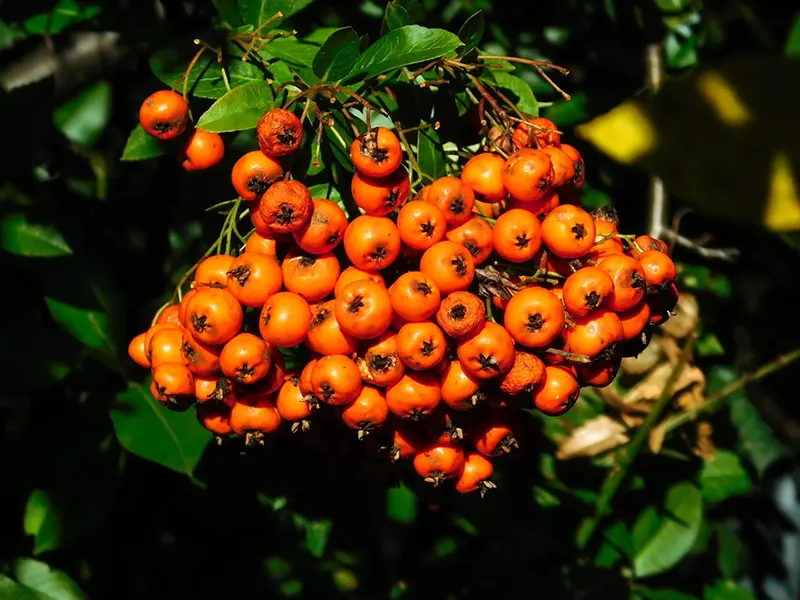
Fruit/Seed
We refer to the fruit of the Pyracantha bonsai as a pome. While you can eat the fruit’s pulp, it’s rather tasteless and without any particular flavor or remarkable texture. However, we have seen people make Firethorn jelly and other food from the berries. It’s with the pomes that you’ll enjoy your bonsai tree, as they vary in color across species, including yellow, red, and orange.
As with almonds, apples, and cherries, the Pyracantha seeds contain cyanogenic glycosides. While you don’t need to be concerned with other fruits, it’s mildly poisonous with the Firethorn tree. It’s best not to ingest the seeds, as it may cause stomach and intestinal issues if you consume too many. Both the fruit and seeds are a rich source of food for birds in winter.
Different Pyracantha Bonsai Varieties
This Firethorn genus has both species and variants. Since there are so few of them, we’ll provide an overview of them here below so that you don’t have to head to places like Wikipedia for the information.
- Species
- Pyracantha angustifolia: narrowleaf firethorn
- P. atalantioides: Gigg’s firethorn
- P. coccinea: scarlet firethorn
- P. crenatoserrata: Chinese firethorn
- P. crenulata: Nepalese firethorn
- P. koidzumii: Taiwanese firethorn
- P. rogersiana: Asian firethorn
- Variants:
- P. ‘Orange Glow’: orange berries
- P. Saphyr Orange (‘Cadange’): orange berries
- P. Saphyr Rouge (‘Cadrou’): orange-red berries
- P. ‘Teton’: orange-yellow berries
- P. rogersiana ‘Flava’: yellow berries
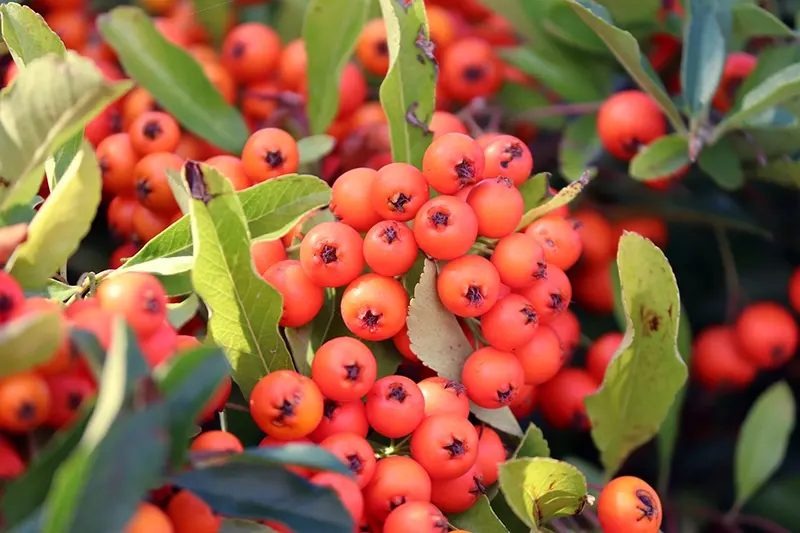
Caring for your Pyracantha Bonsai
If you have or plan on having a Pyracantha bonsai, you’ll need to know how to care for it. It’s generally easy to look after one, but you’ll need to know some details to make sure it doesn’t become infected or die. This part of the guide is the meat
Where to place your Firethorn Tree | Sunlight requirements
While the Pyracantha bonsai loves soaking in as much sunlight as possible, there’s a slight catch. The small leaves are fragile and can burn in direct heat during the hottest part of the day. It’s best to supply several hours of light in the morning with shaded protection when the sun is directly overhead at its peak.
In nature, the Firethorn tree holds out quite well against frost. The issue with the bonsai version is that it doesn’t do too well against extreme cold. You’ll need to provide some shelter during the colder months, possibly with a wire frame and some mesh. It isn’t advisable to bring them indoors, as they do better outside.
Watering and humidity requirements
When you’re in spring, summer, and autumn, you’ll want to keep the roots moist so the roots, leaves, and fruit can remain healthy and strong. It’s quite a thirsty plant, so you’ll want to water as much as possible during the hot days. Keep an eye on the soil and make sure it doesn’t dry out.
You can water your Pyracanth bonsai less in winter, as it won’t need it as much due to the cold weather. Make sure root rot doesn’t set in and that the pot has enough drainage. You also don’t want too much mold to form on the soil or branches, as it can be a danger to your small tree.
Fertilizing and feeding your Pyracantha
There are two approaches to feeding your firethorn tree during the growing months of spring and summer. You can either add a liquid solution to the water every week or opt for the solid pallets once a month. You’ll want to aim for a balance between potassium and phosphorous, as these will help the flowers and fruit grow.
Too much nitrogen will result in more leaves than fruit and flowers. When autumn arrives, you can slow down the feeding but not cut it out completely. As an evergreen tree, it still needs to store food for the winter. Once you’re in the heart of the cold season, you can stop feeding entirely.
Pruning and shaping
When you see long shoots in spring and summer, we recommend you cut back to the second node to encourage more branches to form for dense foliage. You can also remove any dead twigs or leaves you see. It’s best to leave any pruning in winter when it’s resting unless you notice any large leaves on your Pyracantha bonsai.
The Firethorn tree can handle wiring as long as you do so only with young softwood. When the branches become older and hard, they’ll more easily snap and break. We prefer the clip-and-grow technique for a more natural way of shaping the bonsai tree.
How to repot your Firethorn
If you’re Pyracantha is still a young bonsai, you’ll want to repot it every two to three years. As it grows more mature, you can steadily increase it to every five years. The roots grow deep, so you can have a relatively deeper container than the stands shallow ones you see at the bonsai nursery.
Makes sure to clean the roots and lightly prune back to the rootball. Don’t cut any of the major roots unless they’re extending out the drainage holes of the pot. If you want, you can replace the container with a new one that suits the style you’re aiming for.
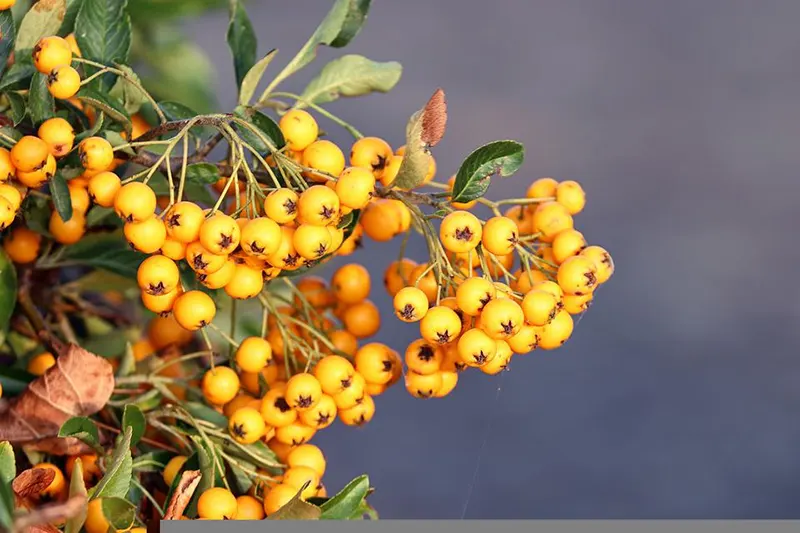
Common Issues with the Firethorn Tree
Pyracantha is sadly susceptible to pests and diseases. If you’re growing it indoors, it will be overcome by mold and small insects that feed on the sap and leaves. While outdoors, there are other pests that will likely overcome it. You can use an organic insecticide or fungicide, but remember to protect it from the elements, too.
Here are some of the more common issues and pests you’ll find with the Firethorn bonsai:
- Aphids
- Scale insects
- Caterpillars
- Fireblight
- Leaf miners
- Root rot
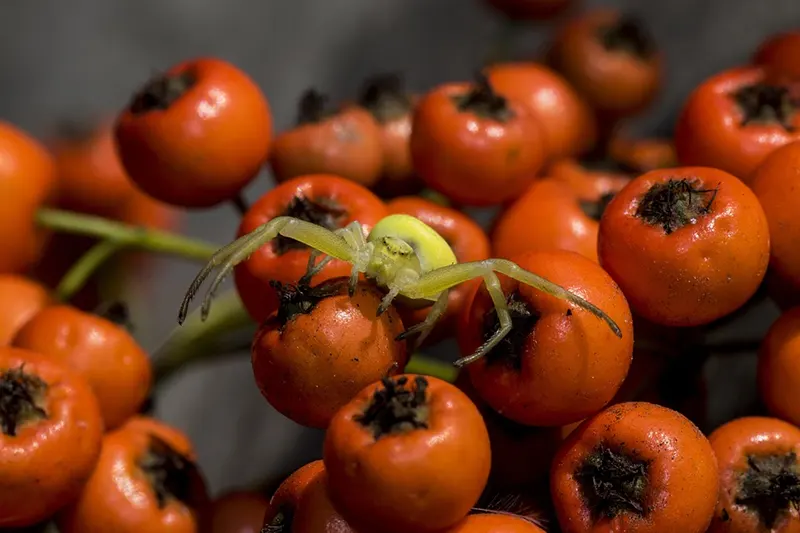
Ways to Propagate a Pyracantha Tree into a Bonsai
Here comes the fun part of our guide on the Firethorn bonsai. We love propagating new bonsais from trees in any way and form possible. It’s really stunning to bring new life into this world, and it is such an outstanding, mystical experience doing it with small trees.
Fortunately, there are a few ways you can do so with a Pyracantha bonsai, namely, seed, cuttings, and air layering. Some are easier than others, but we’re happy to share each type with you here below. In this way, you don’t need to go to a different guide to read about it.
Seeds
If you have a healthy Pyracantha tree in your yard or see one in a park, keep an eye out for bright red or yellow berries. You can take them home and prepare them for propagation. The first step entails removing the outer skin and pulp to get to the seed in the center.
Fortunately, you don’t need to worry about scarification or stratification. All you need to do is put the Firethorn seed in the soil and water it. It’s also a good idea to place a transparent bag over the container, creating a greenhouse effect for your seed. The condensation will keep the soil moist for you, but you can check daily for any drying out.
You should use a put with holes to drain any excess water that’s too much for your soil. If you’re planting more than one in the same soil, make sure there’s at least an inch between each one. When you need to water, do so with a spray bottle to avoid the seeds moving around too much.
It will take a few weeks before you see the first sign of leaves breaking the surface of the soil. Wait until the stem has grown a few inches with at least three layers of leaves before you remove the covering. Keep it indoors with indirect sunlight until the next spring when it should be strong enough to handle outdoor conditions.
Cuttings
The best way to propagate a Pyracantha is from cuttings. If you take new softwood cuttings in spring, it’s too early. By winter, you’ll have hardwood stems when it’s too late. You’ll want to aim for the semi-hardwood branches in the middle of summer for the best chance.
The cutting needs to be between three and six inches long for your Firethorn propagation to be effective. It’s time to remove all the leaves on the lower end of the cutting, at least a third from the bottom tip. Once cleaned, you can cut off a small bit of bark on the bottom tip and cover it with root hormone powder.
You can now place the root in wet soil. You’ll want to make sure it’s not in direct sunlight until you see new leaves appear. To retain the humidity you should cover the pot and cutting with a transparent bag. The water from the soil will evaporate onto the bag at the top and then condensate down again.
It will take about six to eight weeks for new roots to appear. When you see the new leaves, you can move the pot to direct sunlight for a few hours in the morning. You can also remove the bag if you see the leaves are strong enough. Just remember to keep the soil moist.
Air Layering
Another way to grow your own Pyracantha bonsai is through air layering. It’s best to start in early spring when you see new growth appear, which is the ideal time for roots to form. To begin, decide which branch you want to use from a mature tree.
From there, clear about two inches of bark and continue to the cambium layer. You’ll want to remove this too so that the new section is forced to drink from the moisture you’ll provide. When done, apply root hormone and then sphagnum moss around the opening, making sure it’s thoroughly wet.
You’ll want to wrap transparent plastic around the moss to keep everything in place. You can also use ties on either end of the bag to make sure nothing comes loose. Technically, the bag should retain the moisture in the moss, but it may dry out over time. With a small syringe, carefully squirt some water into the moss.
It will take a few seasons before you see roots overwhelm the moss. When you see enough roots, you can cut the new bonsai from the rest of the tree. Make sure you don’t harm the roots during removal or while planting in your new bonsai soil and pot.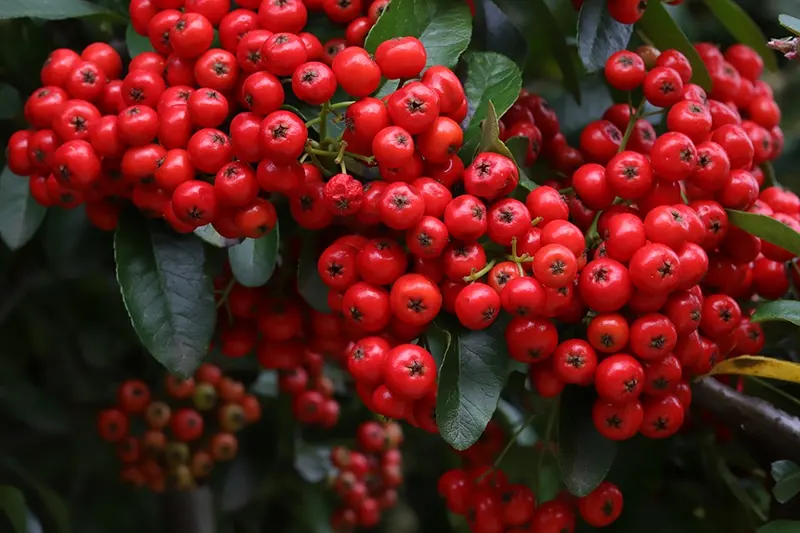
Advantages of Firethorn bonsai for tree designs
You might be wondering why you should get a Pyracantha bonsai. This tree has so many benefits to enjoy when you have it as a small tree in your home. With many possible styles available, your guests will stare in wonder at your Firethorn and ask how they can also have one in their house.
Here are some of the benefits of having a Pyracantha bonsai:
- Broad leaves available all year round
- Plenty of flowers on display
- Loads of berries give it a unique appearance
- Easy to care for
- Wood hardens quickly, making young trees strong
- Excellent for most formal and informal styles
Where to buy a Firethorn bonsai
Have we convinced you to buy a Pyracantha tree and keep it as a bonsai? It’s time to show you where you can get your own one to keep as a prize in your home. There are different ways to acquire it, but you’ll need to know what your options are for each one.
- Local stores: You’d be surprised how many local shops have not only the Firethorn tree but also the Pyracantha bonsai. Since it’s so easy to grow, you’ll find them in large quantities at any bonsai nursery. Some bonsai masters keep them small while others grow them big. It’s up to your preference which one you’d like.
- Markets: Another excellent location to buy these trees is at a tree or farmer’s market. There are some unique designs you’ll like, and you’d be amazed at the types of pots they’re in. You can even buy a small Pyracantha tree and prune it down to a bonsai if you wish.
- Online stores: The most popular spot to buy a Firethorn bonsai is online. Sites like Amazon have tons of them from online sellers, as it’s become one of the number one ways to sell these small trees. The only downfall is that the displayed image doesn’t represent how your tree will look when it reaches you. So you’re taking a chance on a healthy bonsai.
- Social media: If you enjoy mingling with the local community, head onto Facebook groups or Instagram feeds and see if anyone is selling one of these trees. You can also use hashtags to narrow down your search. Sometimes, you’ll be in luck by someone giving one away for free.
- Bonsai events: Some countries are lucky enough to have a bonsai convention or event every month. If you’re in such an area, be on the lookout for one near you. They sometimes have Firethorn bonsai trees for sale or on auction, and you might just score an absolutely incredible deal.
- Open fields: Not in the mood to spend money? Head on down to a field that’s known for having Pyracantha trees and use one of our methods to propagate one. It’s better to take cuttings, as you’ll have a small bonsai sooner than the other ways. Just be sure you’re allowed to take cuttings, as some community parks are protected from such actions.
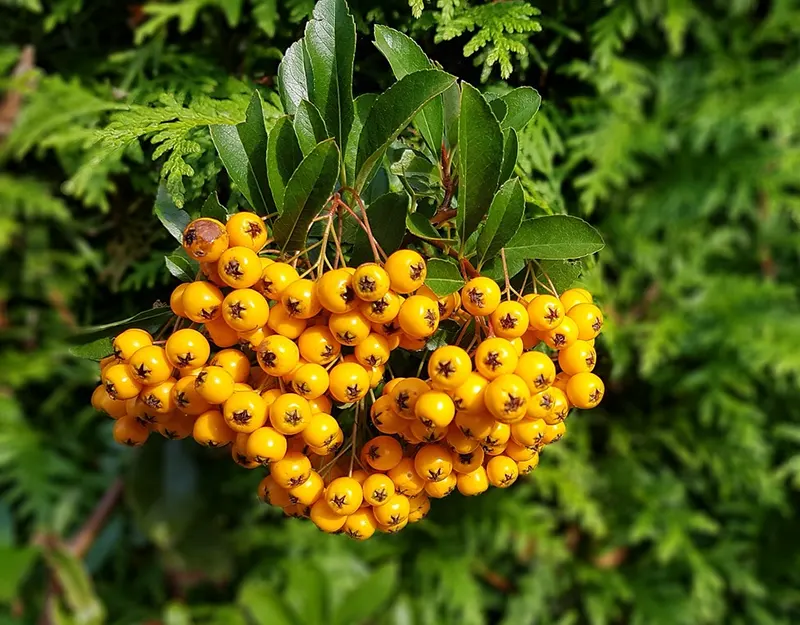
Common Questions on the Pyracantha bonsai
We’re almost at the end of our Firethorn bonsai guide. Before you leave, we want to make sure we answer as many questions that you might have. Some of these are from popular questions people always ask online, while others are from chat forums. Feel free to send us any queries you might have.
Can you bonsai a Pyracantha tree?
Yes, it’s entirely possible and encouraged to bonsai a firethorn tree. It’s one of the top genera to develop into a bonsai, as it’s easy to maintain and keeps its broad leaves for the entire year. You’ll see it rest in the winter with new leaves appearing in spring.
The informal and formal styles are both suitable for these trees. Small, moderately-deep pots are suitable for them, giving the roots space to grow. After about three years, you’ll want to change the soil and prune the roots to make sure it remains healthy and strong.
What is a Firethorn bonsai tree?
Firethorn is just another name for a Pyracantha bonsai. It’s a genus consisting of about seven species, but there are a few other variants you can grow. The name is derived from two Greek words that represent the fiery nature of the red, yellow, or orange berries, making the leaves look like they’re alight.
How do you care for a Pyracantha bonsai tree?
It’s easy to care for a Pyracantha. All you need to do is make sure it has enough sunlight, water, humidity, and food throughout the growing seasons. In winter, all you need to do is ensure there’s enough sunlight, and just touch up the water when necessary.
We’ve already provided a detailed guide above for how to care for the Firethorn bonsai tree. We’re happy to give you any other details you might need to know. Beginners won’t find it too challenging to keep this tree alive and well but sometimes, the conditions might not be right for it.
Are Pyracantha berries poisonous to humans?
The berries of the Pyracantha aren’t poisonous, and there are some recipes that make use of the pulp. However, it’s the seeds you need to watch out for, which are mildly toxic. If you eat too much of them, you might end up with some stomach and digestion issues.
If you find that you’re not feeling well, just stay away from the berries until you feel better. Should it result in vomiting or worse conditions for more than a day, it may be best to see a doctor for medical attention. Hopefully, your condition doesn’t become so bad. If you follow a recipe with berries as an ingredient, make sure you follow it in every aspect.
Is Pyracantha a bush or a tree?
Technically, Pyracantha is a shrub. That doesn’t mean you can’t grow it as a bonsai. There are many shrubs and bushes that we develop as bonsai trees, such as Bougainvillea. In the wild, the Firethorn doesn’t usually grow tall enough to really be classified as a tree.
However, we don’t refer to it as a bonsai bush. We still call it a bonsai tree. The reason is for how we style and shape it, which makes it look more like a tree than a bush or shrub. It’s also common to refer to bonsais as trees.
Is Firethorn poisonous to cats and dogs?
While the Pyracantha’s seeds are harmful to humans, you’ll want to keep the berries and seeds away from cats and dogs. It’s highly poisonous to them. Normally, they won’t really try to eat them, but you may find birds trying to nibble at the delicious fruit.
Firethorns are popular as hedges in some countries, which is where you’ll need to be careful. If you have a dog that loves to eat everything it sees, using it as a hedge around your home may not be a good idea. If you do, you may want to keep the ground clean around it when the berries fall during autumn.
How to make your Pyracantha bonsai bushy?
The best way to make a Pyracantha bonsai bushy is to keep pruning through spring and summer. As soon as you see it has a few leaves and nodes on a branch, cut back to the second set. When you see new shoots appear from that cutting, you repeat the process. It will ensure that many small twigs form.
There’s only one issue with this process. If you perform heavy pruning in summer, you’re less likely to see flowers and fruit. The reason is that the Firethorn tree is focusing more on producing leaves, causing a reduction in flowers and fruit. You’ll have to decide what’s more important for you during that specific season.
Is Pyracantha evergreen?
Yes, Pyracantha is an evergreen genus, no matter which species you choose to grow as a bonsai. The broad green leaves remain for the entire year, while growth slows down in winter. That means it still has a dormancy period to rest, but you won’t see the healthy leaves change color or fall.
If the leaves are dropping, that means there’s probably something wrong. Sure, you might see it lose some old leaves when spring arrives, but it shouldn’t be too many. It could be that there’s a fungus infecting the tree or there’s a disease in the fruit or roots. It’s best to take corrective measures to make sure your bonsai thrives again.
To what family does the Firethorn belong?
The Firethorn tree belongs to the Rose family, which you won’t immediately detect from its small flowers. However, that would explain why it remains a bush. To drill down further, it belongs to the apple plum order and the apple tribe. You could imagine the small berries as tiny apples if you want, but the fruits are different.
Can you take cuttings from Pyracantha?
Using Firethorn cuttings is one of the top ways to propagate a Pyracantha tree. It’s best to use semi-hardwood from new branches that appeared, taking them from the tree in summer. When done right, you’ll have a new bonsai in your collection that mimics the parent tree.
We’ve provided some tips already for how to propagate a Pyracantha using cuttings. Remember, you need to cover the lower tip with rooting hormone if you want to succeed. From there, you just need to give it love and time until you see new leaves and roots appear.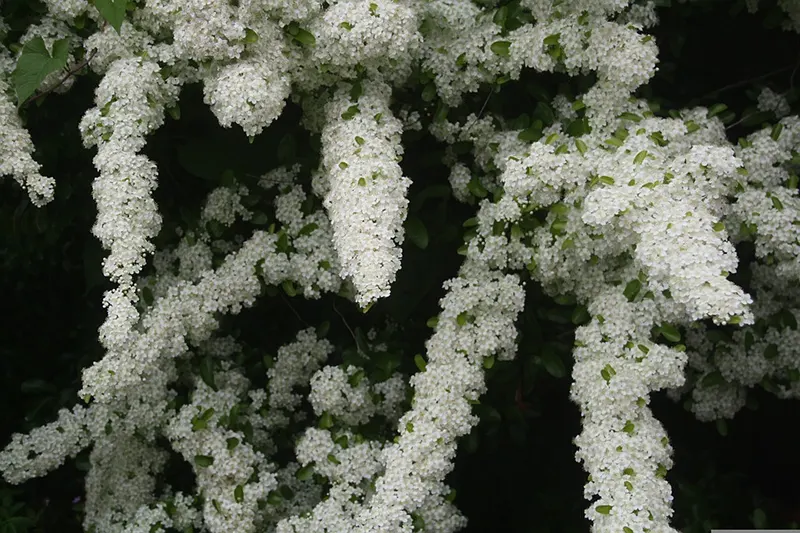
Final Thoughts on the Firethorn Tree
The Pyracantha bonsai is a stunning tree to grow. The leaves, flowers, and berries are all gorgeous, and it’s easy to keep it as small as you’d like. It’s even viable as a shohin, which is keeping it as small as one to two inches high.
I hope this guide has helped you in some way learn more about the Firethorn tree and caring about it as a bonsai. Remember, we’re always around if you need guidance in any way. Just hit us up on email or social media, and we’ll be sure to respond.



